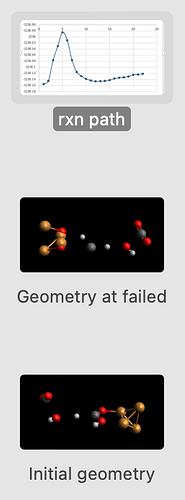Hi,
I am running a transition state calculation now. I got a really pretty reaction path and I selected a few points around step 5. I gave 500 cycles but the following input returned me a crushed message of max opt cycles reached with a strange geometry, in which O is overlapping with Cu. So I am confused about why the transition state search failed in this way. I will really appreciate it if someone can take a look at my problem and provide some suggestions. Thanks!
PS: apologize for the small figures. The web wouldn’t allow me to put more than one media.
$molecule
0 1
Cu -1.51531 1.00268 0.80106
Cu 0.18483 -0.78162 0.60421
Cu 0.21504 0.98986 -0.92798
Cu -1.43812 -0.81013 -1.27062
C 3.10891 -0.32409 0.14309
O 2.50592 0.63890 -0.66855
O 2.27050 -0.97344 0.75331
H 5.17436 -0.53132 0.05038
H 3.19913 1.14308 -1.10418
C 8.46380 0.29815 1.86239
O 8.83337 -0.79206 2.12445
O 7.39174 -0.17959 -0.22744
O 8.18314 1.43919 1.85159
H 8.03812 -0.91092 -0.32667
$end
$rem
JOBTYPE ts
METHOD wB97X-D3
BASIS general
MAX_SCF_CYCLES 10000
SCF_ALGORITHM = GDM
GEOM_OPT_MAX_CYCLES 1000
$end
$basis
Cu
lanl2dz
C
6-31g*
N
6-31g*
O
6-31g*
H
6-31g*
$end
$ecp
Cu
fit-lanl2dz
$end
$opt
FIXED
1 xyz
2 xyz
3 xyz
4 xyz
ENDFIXED
$end
